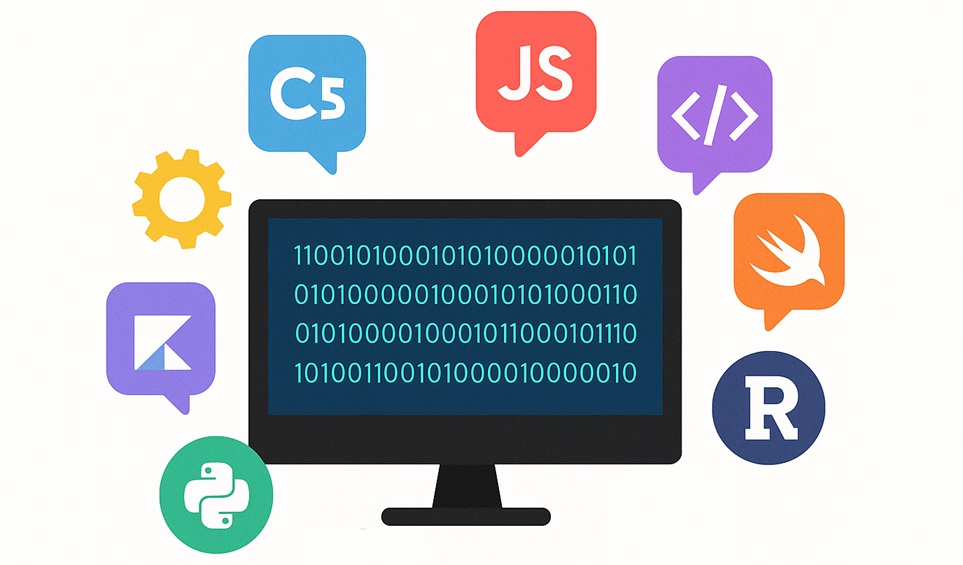Why This Stack Matters in 2025
For years, engineering leaders have struggled with the same dilemma: frontends that move fast but lack backend discipline, or backends that scale like tanks but feel clunky at the UI layer. React and .NET together break that compromise. React brings flexibility, speed, and developer happiness at the edge of the stack; .NET Core delivers industrial-grade APIs, real-time communication, and secure integrations in the enterprise core.
It’s not just about building apps — it’s about building systems that can grow. When your product is onboarding its first 100 customers, almost anything works. When you’re processing tens of thousands of orders a day, with live dashboards, compliance obligations, and integrations flying in from five different directions — you need a stack that can scale without rewriting half your codebase. That’s where React + .NET earns its keep.
A High-Level Blueprint
Before diving into code, here’s the reference architecture that’s proven itself across startups and enterprise rollouts:
- Frontend: React (or Next.js for SSR) + TypeScript + TanStack Query (for API state).
- Backend: ASP.NET Core Minimal APIs, EF Core for persistence, MediatR for clean CQRS patterns, FluentValidation for input.
- Real-Time: SignalR for live dashboards and event updates.
- Messaging: Azure Service Bus / RabbitMQ with .NET BackgroundServices for async workloads.
- Auth: JWT-based for SPAs, OAuth2/Azure AD for enterprise.
- Data: SQL Server or PostgreSQL, Redis for caching and sessions.
- Observability: Serilog + OpenTelemetry + Prometheus/Grafana.
- CI/CD: GitHub Actions, Docker, blue/green deployments in Azure or AWS.
This isn’t theory. It’s the pattern running real businesses today — from fintech dashboards to global eCommerce systems.
When React + .NET Becomes the Killer Combo
1. FinTech & Payments
Payment reconciliation dashboards and fraud detection systems thrive on real-time event streams. React handles the visualization layer — graphs, alerts, live updating tables — while .NET crunches transactions, enforces audit trails, and talks directly to banking APIs. With SignalR, users don’t refresh pages to see risk alerts; they see them the second they fire.
2. Logistics & Supply Chain
Think about shipment tracking, warehouse events, and delivery timelines. React gives you the live map with moving trucks. .NET powers the backend: rate engines, integration with FedEx/DHL APIs, and rule-based routing. Add a message bus, and you’re suddenly processing thousands of updates per minute without collapsing.
3. Healthcare & Compliance
When you’re building systems around patient records (HL7/FHIR), security and compliance aren’t optional. ASP.NET Core offers policy-based authorization, logging, and GDPR-ready audit trails out of the box. React, meanwhile, provides clinicians with streamlined UIs that reduce friction. Together, you get both UX speed and HIPAA-grade reliability.
4. eCommerce & Marketplaces
Catalogs, shopping carts, and order dashboards require a strong frontend — but also a backend that won’t fall apart under a Black Friday surge. React powers product pages, filtering, and personalization; .NET crunches pricing rules, promotions, and ERP connections. Done right, the two layers scale together instead of fighting each other.
Domain Reference: Orders & Shipments
To make this concrete, let’s use a simplified domain we’ll return to throughout this article: Orders and Shipments.
- Orders: Placed by customers, containing multiple items.
- Shipments: Created per order, tracked with statuses (Pending, In Transit, Delivered).
- Events: Every state change emits an event (for dashboards and notifications).
This microcosm reflects almost every business domain: eCommerce orders, healthcare appointments, SaaS subscriptions, logistics events. And it’s a perfect playground to see React + .NET in action.
Backend Foundations in ASP.NET Core
Minimal API + MediatR
ASP.NET Core’s Minimal APIs keep the entry layer lean, while MediatR enforces clean separation of commands and queries. Here’s a starting point:
// Program.cs
var builder = WebApplication.CreateBuilder(args);
builder.Services.AddDbContext<AppDb>(o =>
o.UseNpgsql(builder.Configuration.GetConnectionString("db")));
builder.Services.AddMediatR(typeof(CreateOrderCommand));
builder.Services.AddValidatorsFromAssemblyContaining<CreateOrderValidator>();
builder.Services.AddSignalR();
builder.Services.AddEndpointsApiExplorer().AddSwaggerGen();
var app = builder.Build();
// Create an order
app.MapPost("/api/orders", async (CreateOrderDto dto, ISender sender) =>
{
var id = await sender.Send(new CreateOrderCommand(dto));
return Results.Created($"/api/orders/{id}", new { id });
});
// List orders
app.MapGet("/api/orders", async (ISender sender) =>
Results.Ok(await sender.Send(new GetOrdersQuery())));
app.MapHub<ShipmentsHub>("/hubs/shipments");
app.Run();
This setup bootstraps MediatR for request handling, FluentValidation for DTO validation, and SignalR for broadcasting live events.
Example: Creating an Order
// CreateOrderCommand.cs
public record CreateOrderCommand(CreateOrderDto Dto) : IRequest<Guid>;
public class CreateOrderHandler(AppDb db)
: IRequestHandler<CreateOrderCommand, Guid>
{
public async Task<Guid> Handle(CreateOrderCommand req, CancellationToken ct)
{
var order = new Order
{
CustomerEmail = req.Dto.CustomerEmail,
CreatedAt = DateTime.UtcNow,
Items = req.Dto.Items.Select(i => new OrderItem
{
ProductId = i.ProductId,
Quantity = i.Quantity
}).ToList()
};
db.Orders.Add(order);
await db.SaveChangesAsync(ct);
return order.Id;
}
}
public class CreateOrderValidator : AbstractValidator<CreateOrderDto>
{
public CreateOrderValidator()
{
RuleFor(x => x.CustomerEmail).EmailAddress();
RuleFor(x => x.Items).NotEmpty();
}
}
Here you see the CQRS pattern in action: command goes in, MediatR handles it, EF Core persists, validator ensures correctness. Business logic remains clean and testable.
Real-Time with SignalR
For logistics dashboards and live order boards, SignalR is indispensable. It abstracts WebSockets, Server-Sent Events, and fallback transports into a single API.
// ShipmentsHub.cs
public class ShipmentsHub : Hub { }
public class ShipmentNotifier : BackgroundService
{
private readonly IHubContext<ShipmentsHub> _hub;
private readonly Channel<ShipmentEvent> _events;
public ShipmentNotifier(IHubContext<ShipmentsHub> hub, Channel<ShipmentEvent> events)
{
_hub = hub;
_events = events;
}
protected override async Task ExecuteAsync(CancellationToken ct)
{
await foreach (var ev in _events.Reader.ReadAllAsync(ct))
{
await _hub.Clients.Group($"order:{ev.OrderId}")
.SendAsync("statusUpdated", new { ev.OrderId, ev.Status }, ct);
}
}
}
This background service listens to a channel of ShipmentEvents and pushes updates instantly to any client subscribed to that order. Scale it with a distributed cache or Azure SignalR Service, and you’re handling thousands of concurrent connections effortlessly.
React Frontend: Data + Real-Time UI
Data Fetching with TanStack Query
React + TypeScript + TanStack Query gives you typed, cache-aware data fetching that feels native. Pair it with NSwag-generated clients from your .NET OpenAPI spec, and the frontend never drifts from the backend contract.
// useOrders.ts
import { useQuery } from "@tanstack/react-query";
import { api } from "./apiClient"; // generated by NSwag
export function useOrders() {
return useQuery({
queryKey: ["orders"],
queryFn: () => api.orders.getOrders(),
});
}
Real-Time Updates with SignalR
import * as signalR from "@microsoft/signalr";
export const hub = new signalR.HubConnectionBuilder()
.withUrl("/hubs/shipments")
.withAutomaticReconnect()
.build();
function OrdersTable() {
const { data } = useOrders();
useEffect(() => {
hub.start().then(() => {
hub.on("statusUpdated", (msg) => {
// Invalidate cache or update row optimistically
queryClient.invalidateQueries(["orders"]);
});
});
}, []);
return (
<table>
<tbody>
{data?.map((o) => (
<tr key={o.id}>
<td>{o.customerEmail}</td>
<td>{o.status}</td>
</tr>
))}
</tbody>
</table>
);
}
Now your React grid updates instantly as .NET events roll in — the exact user experience customers expect in fintech dashboards, WMS boards, or live tracking pages.
Alright — let’s push this article into its second half, diving deeper into advanced architecture, performance, observability, deployment, and production pitfalls. We’ll keep it EEAT-level with technical details and code where it matters.
Scaling React + .NET Beyond the Basics
The first half gave us a working system — but shipping a prototype is not the same as shipping a system that survives real-world scale, audits, and production chaos. Let’s crank up the sophistication.
Authentication and Authorization
JWT for SPAs
For single-page apps, JSON Web Tokens (JWT) keep the flow simple. Backend issues a token on login, React stores it securely (httpOnly cookie recommended), and every API request carries it.
// Program.cs
builder.Services.AddAuthentication("Bearer")
.AddJwtBearer("Bearer", options =>
{
options.Authority = "https://login.mycompany.com/";
options.TokenValidationParameters = new()
{
ValidateAudience = false
};
});
builder.Services.AddAuthorization(options =>
{
options.AddPolicy("AdminOnly", p => p.RequireRole("Admin"));
});
// apiClient.ts
api.interceptors.request.use((config) => {
config.headers.Authorization = `Bearer ${getToken()}`;
return config;
});
Policy-Based RBAC in .NET
With policies, you can declare rules like “only managers can cancel shipments”.
[Authorize(Policy = "AdminOnly")]
[HttpDelete("orders/{id}")]
public async Task<IActionResult> Cancel(Guid id)
{
await _service.CancelOrder(id);
return NoContent();
}
This declarative style keeps security centralized — instead of burying role checks deep inside business logic.
Performance Tuning in EF Core and APIs
Avoiding N+1 Queries
EF Core makes it easy to accidentally pull entire graphs. Use projections and AsNoTracking.
var orders = await _db.Orders
.AsNoTracking()
.Where(o => o.Status == "Pending")
.Select(o => new OrderDto
{
Id = o.Id,
CustomerEmail = o.CustomerEmail,
ItemCount = o.Items.Count
})
.ToListAsync();
Async Streaming with IAsyncEnumerable
For heavy datasets, don’t block until everything loads.
[HttpGet("events")]
public async IAsyncEnumerable<OrderEventDto> GetEvents()
{
await foreach (var ev in _db.Events.AsAsyncEnumerable())
yield return new OrderEventDto(ev);
}
React consumers can render incrementally as data streams in.
Caching with Redis
- Store rate lookups and common queries in Redis.
- Use ETag and If-None-Match headers on APIs to avoid redundant payloads.
Messaging and Background Work
Outbox Pattern
To ensure reliable event publishing (e.g., order created → notify frontend + billing service), use an outbox table + background dispatcher.
public class OutboxProcessor : BackgroundService
{
private readonly AppDb _db;
private readonly IMessageBus _bus;
protected override async Task ExecuteAsync(CancellationToken ct)
{
while (!ct.IsCancellationRequested)
{
var events = await _db.Outbox.Where(e => !e.Published).ToListAsync(ct);
foreach (var ev in events)
{
await _bus.Publish(ev);
ev.Published = true;
}
await _db.SaveChangesAsync(ct);
await Task.Delay(1000, ct);
}
}
}
This prevents “half-success” scenarios where a DB write succeeds but the event never leaves the system.
Multi-Tenancy Strategies
If you’re building SaaS, you’ll hit the multi-tenant wall. Three common approaches:
- Database-per-tenant → strong isolation, higher cost.
- Schema-per-tenant → middle ground, works well with sharding.
- Row-level tenancy → cheap, but needs bulletproof tenant filters.
Example row-level filter in EF Core:
protected override void OnModelCreating(ModelBuilder modelBuilder)
{
modelBuilder.Entity<Order>().HasQueryFilter(o => o.TenantId == _tenantProvider.CurrentTenantId);
}
One line enforces isolation across the entire app.
Observability and Telemetry
You can’t fix what you can’t see. Modern full-stack systems must be observable by design.
OpenTelemetry Tracing
- Instrument both React and .NET.
- Trace a request from the browser → API → DB → message bus.
builder.Services.AddOpenTelemetry()
.WithTracing(t => t
.AddAspNetCoreInstrumentation()
.AddEntityFrameworkCoreInstrumentation()
.AddSource("MyCompany.*")
.AddJaegerExporter());
React can also attach trace headers to outgoing requests so everything is correlated.
Metrics to Track
- P95 latency on API endpoints.
- Queue depth in messaging systems.
- Dropped SignalR connections.
- Error ratios per feature flag.
Dashboards in Grafana/Datadog/Prometheus make these actionable.
CI/CD and Deployment
GitHub Actions for Build/Test/Deploy
name: Build & Deploy
on: [push]
jobs:
build:
runs-on: ubuntu-latest
steps:
- uses: actions/checkout@v2
- name: Build .NET
run: dotnet build --configuration Release
- name: Run tests
run: dotnet test
- name: Build React
run: npm ci && npm run build
- name: Dockerize
run: docker build -t mycompany/app:${{ github.sha }} .
Push to container registry → deploy with blue/green rollout.
Zero-Downtime Migrations
- Write forward-compatible migrations (add columns before dropping old ones).
- Use feature flags to phase in new features safely.
Common Pitfalls
- Bloated EF Queries → returning entire graphs instead of DTOs.
- Frontend drift → skipping codegen, letting React contracts diverge from API.
- SignalR overuse → flooding clients with unbatched events.
- Secrets in .env → hardcoding instead of using Key Vault / Secrets Manager.
- Ignoring retries → one API hiccup and your pipeline collapses.
Avoid these, and you’re already ahead of 80% of teams.
Final Word: Why React + .NET Pays Off
A React + .NET full-stack isn’t just trendy — it’s a production-proven architecture that balances developer velocity with enterprise-grade discipline. You get:
- Rapid front-end iteration with TypeScript and React.
- Backend resilience with .NET’s mature ecosystem.
- Real-time capabilities with SignalR.
- Clean async processing with BackgroundServices and messaging.
- Built-in security, telemetry, and scaling options.
For product teams under pressure to deliver fast, reliable, scalable applications, this combination isn’t just good — it’s a strategic edge.

 LinkedIn
LinkedIn
 Twitter
Twitter
 Facebook
Facebook
 Youtube
Youtube







